We’re back with another week of the PLV report. This series will use the PLV metrics to contextualize player performance, and this week we’ll use our PLV model (Nick’s primer on PLV from last year can be found here) to validate some early-season pitching performances. PLV allows us to dig into individual pitches as needed, or to analyze how a pitcher’s repertoire works holistically. When showing Pitch Type cards, there will also be a plvLocation+ score shown, which is modeled similarly to PLV, but only uses the end locations of the pitch (horizontal, vertical, and location within the specific hitter’s strike zone) as inputs.
Now that the calendar has moved into May, we are seeing pitchers start to move past the 500-pitch threshold, which is the point in the season where PLV begins to stabilize. This is also true of their PLA, which converts PLV to an ERA scale. Let’s take a look at some early-season pitchers who are over- or under-performing their preseason expectations, and see if PLV backs up their performance.
Note: PLV metrics listed are current through Monday, May 5th.
Kikuchi has continued his strong run of play from 2023, as he’s off to a great start with a 2.72 ERA and a 21% K-BB% through his first 7 games. It may be easy to see his 5.9% HR/FB rate and 78.7% LOB% and write it off as luck, but he’s also running a .324 BABIP (league-average is .287), so it can’t all be written up to luck.
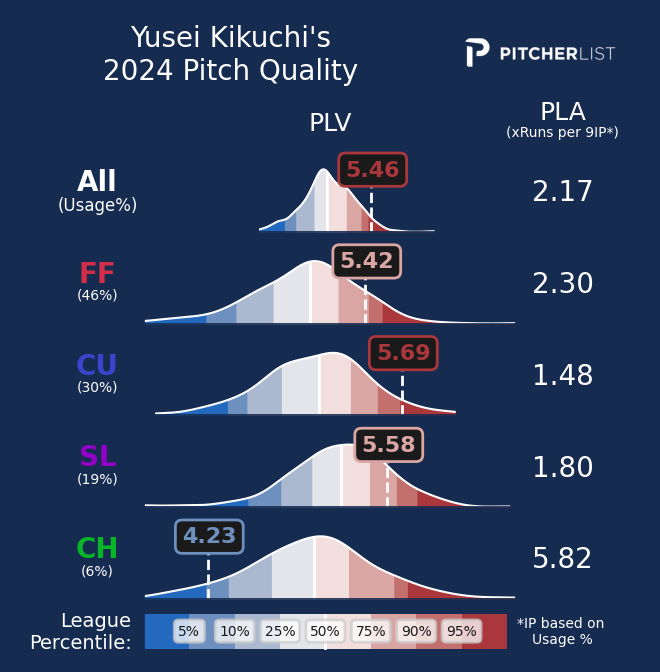
Looking into his pitch repertoire, and Kikuchi has a handful of strong pitches that are driving this hot start. The Four-Seam, Curveball, and Slider are all strongly above average and are also his 3 most used pitches. The Curveball, in particular, has been spectacular at limiting contact quality (.241 xwoBACON) while being above average at getting both Called Strikes (22.1%) and Swinging Strikes (12.1%). The Changeup is used sparingly, and functions as a show-me pitch, which is fine when you have a 3-pitch base as good as Kikuchi’s is.
Pérez is having a useful season for the Pirates so far. He’s already surpassed his 2023 fWAR (0.8 vs 0.5 in 141 2/3 IP), thanks to a sparkling 3.37 FIP that accompanies a 3.15 ERA. Pérez also has almost identical HOTEL markers to Kikuchi above: 4.4% HR/FB, .323 BABIP, and 77.5% LOB%, so there’s an argument to be made that he hasn’t been lucky, either.
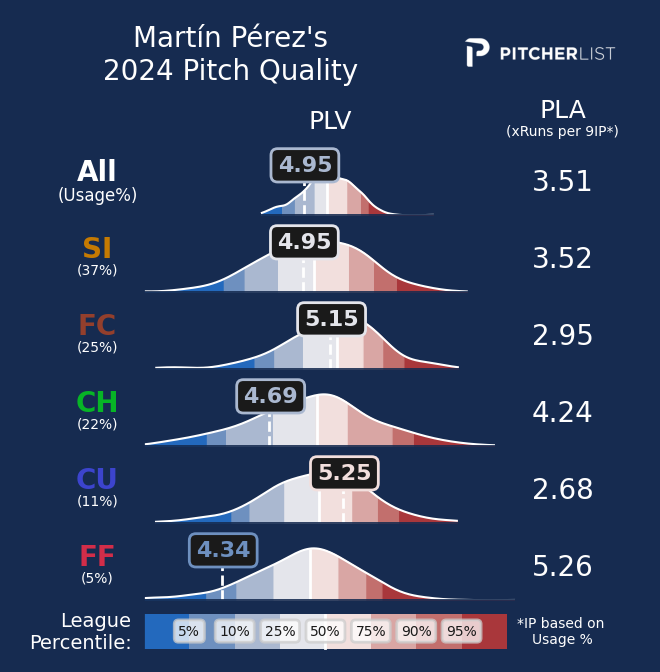
His underlying metrics are the problem, for me. PLV is generally not a huge fan of Sinkers, and Pérez’s isn’t a sterling example of the pitchtype. His Cutter and Curveball are the only pitches that rate as above-average pitches (and even then, the Cutter is still below the pitchtype average). This can also be seen in his results: his 21st percentile Swinging Strike rate (9.2%) leads to a 25th percentile K% (18.0%). I expect negative regression to come for Pérez if he maintains this pitch quality (his 4.28 xFIP and 5.34 xERA agree).
Imanaga may have the most valuable pitch in baseball, through the season’s first few weeks. That’s all the more impressive when you realize that it has below-average velo and Imanaga doesn’t get a lot of extension either.

What makes his fastball tick is the combination of great IVB, a very good Height Adjusted Vertical Approach Angle (HAVAA), and impeccable locations at the top of the zone. That IVB/HAVAA combo is even deadlier up in/above the zone, resulting in his league-leading PLV on the pitch. Even when it’s in the zone, he locates the fastball in places it won’t hurt him (he’s thrown a single mistake pitch, for a 0.3% Mistake Rate). PLV thinks that the contact suppression by the pitch (.271 xwoBACON) is legit, and will help the surprisingly low 26.5% CSW rate play up.
Don’t overthink it. There’s a reason his name is I’m an AGA.
Stone’s bread and butter is his Changeup (70 present and future grade, according to FanGraphs). The main issue is that the bread is stale and the butter dish is empty (HAISTBMBWT?!). Stone’s Changeup serves as a nearly perfect foil to Imanaga’s Four-Seam: above-average velo and extension, undone by average movement and horrendous locations.
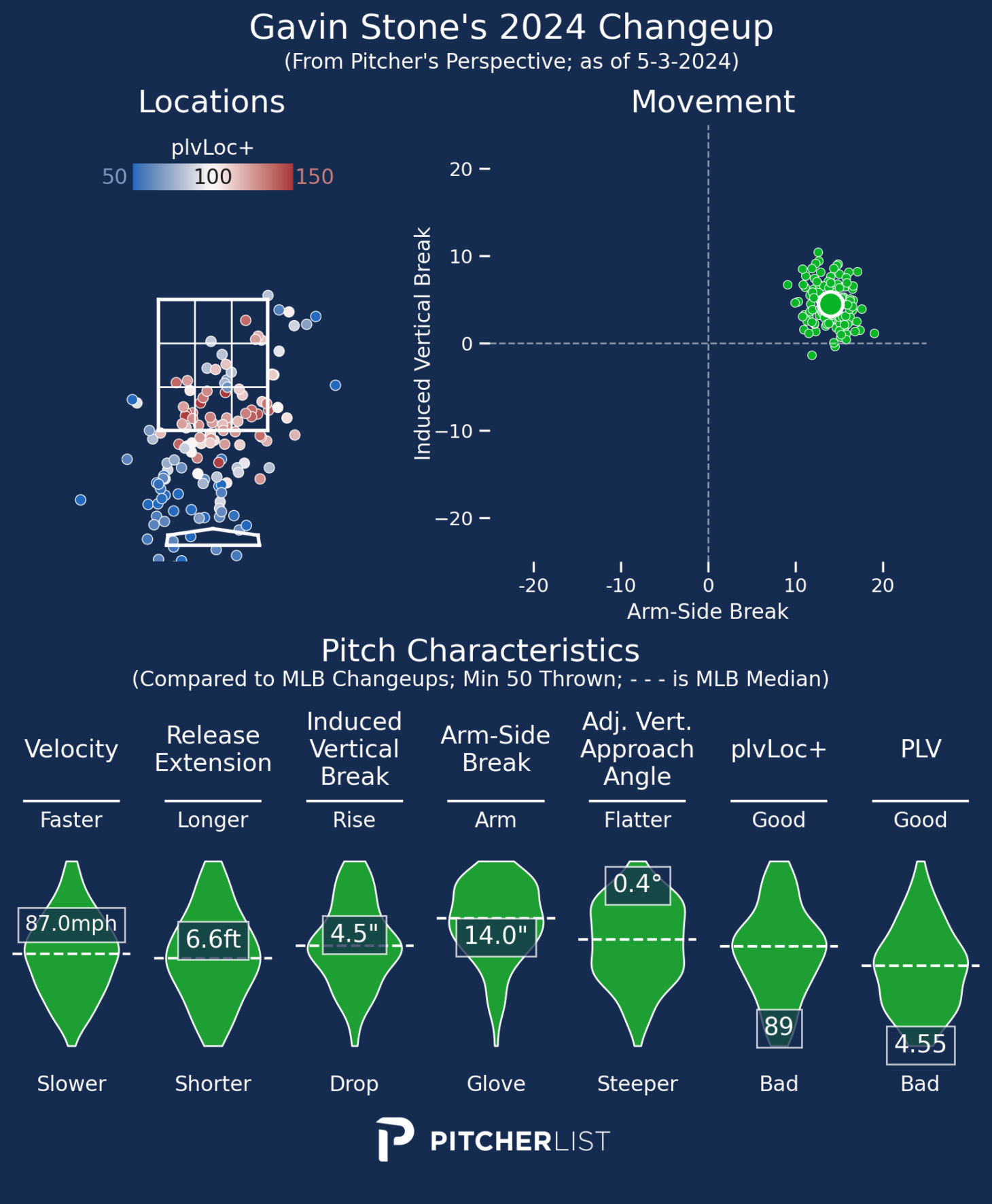
As you can see by the location plot on the card, Stone is spiking way too many Changeups in the dirt. Those aren’t competitive pitches, and MLB hitters are smart: if they can identify the Changeup out of Stone’s hand, they know that it’s likely to completely miss the zone (27.5% Zone% and 5.1% Called Strike%). If he can locate those a bit closer to the zone, the pitch could really thrive, but it’s currently a bit too wild to be the elite pitch that it was in the minors.
Paddack has a classic 4-pitch starter’s repertoire: mid-90s fastball that he can spot extremely well, a hard gyro Slider, a Changeup for platoon-proofing and changing speeds (10mph slower than the Four-Seam!), and a big Curveball to really change gears and mess with a hitter’s timing. The unifying characteristic of all of these pitches? A 7ft extension that gives the hitter less time to identify which pitch is coming.

Paddack does a great job of keeping his pitches in and around the zone. Note how much closer to the zone Paddack’s Changeup is, compared to Stone’s. That ability to locate drives his walk prevention (<5% BB rate) and limits the frequency of his mistakes (<5% Mistake rate). Paddack has been hit around this season and doesn’t have the wipeout stuff to strike out a lot of hitters. That doesn’t mean he can’t be a successful and useful pitcher, and PLV believes there’s a turnaround coming (which has hopefully already started with 6 IP of run-free baseball on 5/3. With 6 Ks!).

Lynn is a proponent of the “kitchen sink” approach: he throws 6 different pitches and hopes the volume of looks will bail him out from each of them being below-average by PLV (in some cases far below average).
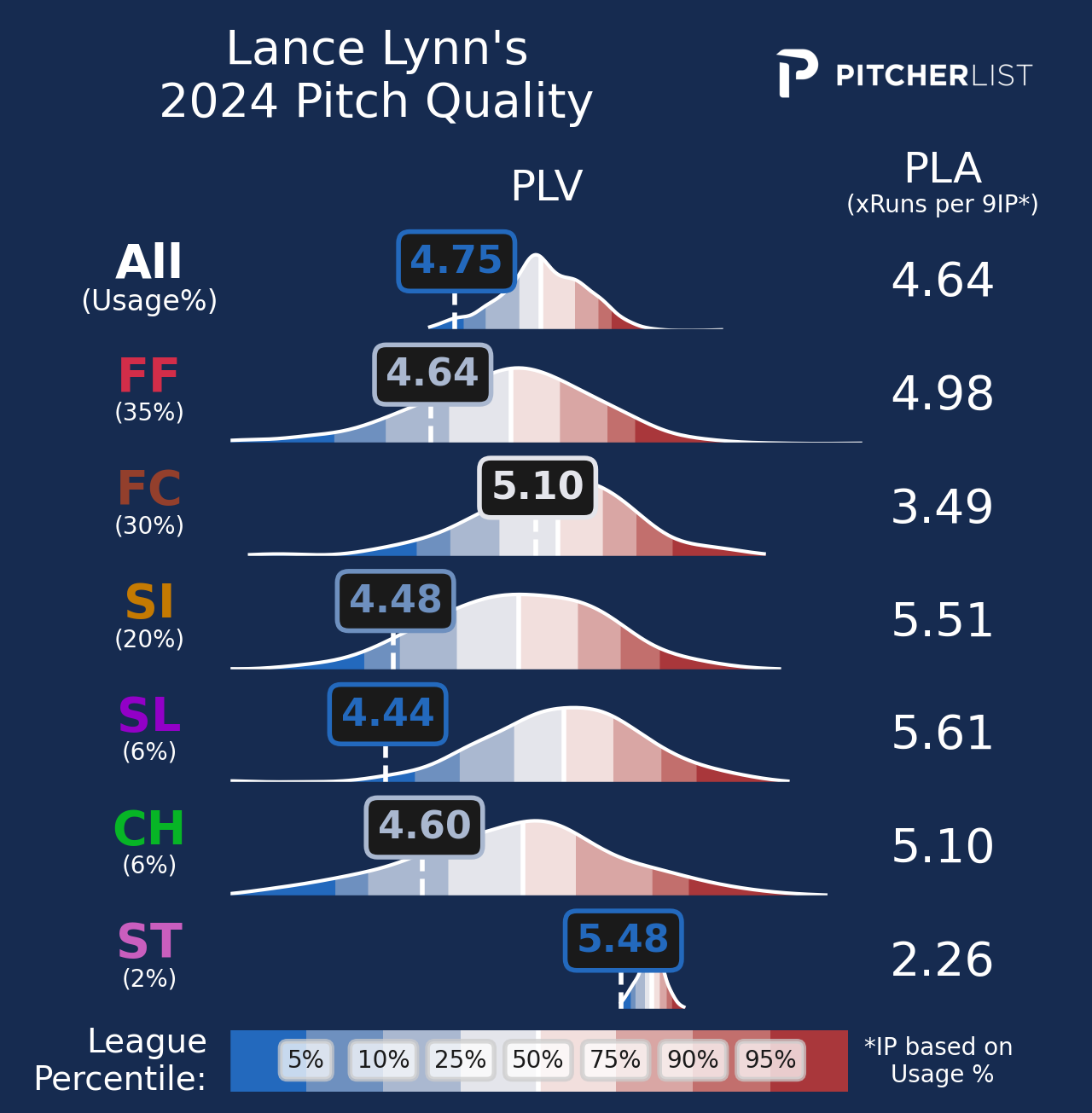
The lackluster PLV grades are a result of ineffective locations. All of his pitches have sub-par plvLocation+, with the Sinker, Slider, and Changeup returning particularly egregious values in the 80s (100 is average). This has resulted in a double-digit walk rate (10.1%), and puts a lot of pressure on his stuff to get strikes and limit hard contact. He’s managed to walk that tight rope so far, but PLV is skeptical of it continuing.
Sandoval’s Slider is doing a ton of work for him and will help him going forward (Edit: sure enough, he pitched a gem while I was writing this blurb!). It’s an interesting combination of being a hard Slider that also gets above-average horizontal break, and Sandoval locates it extremely well.
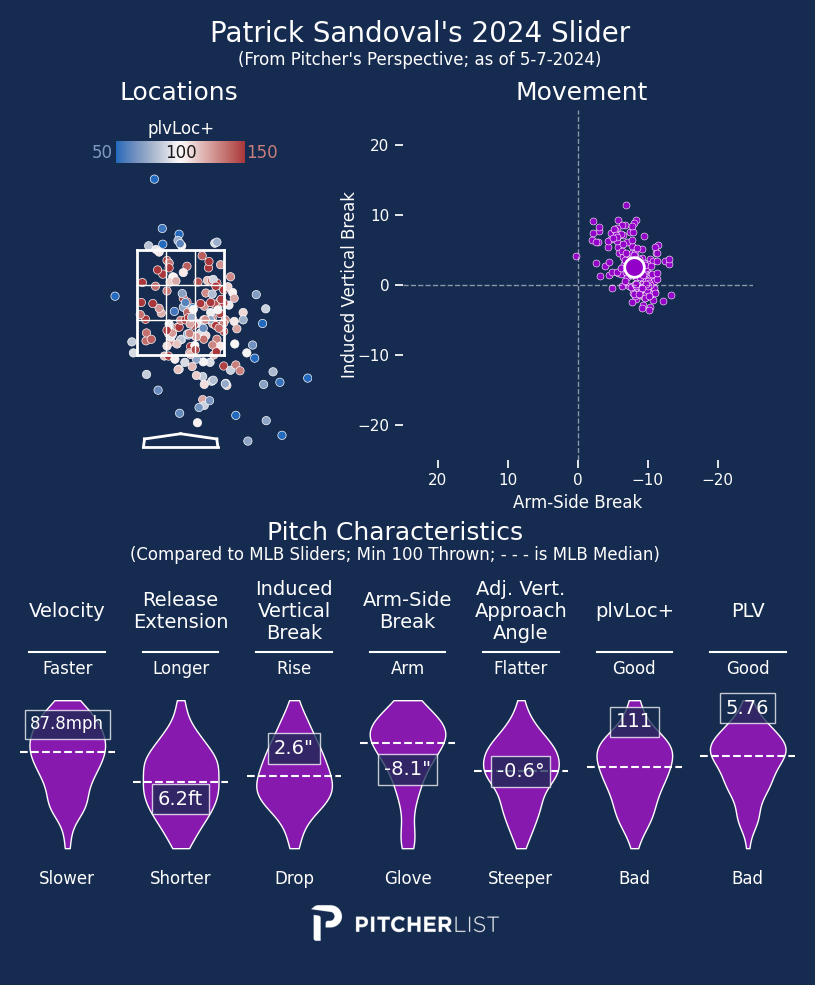
The Slider is easily the pitch that carries Sandoval, with the rest of his repertoire grading roughly average. Thankfully, one elite pitch paired with multiple average ones is a strategy that can work (as Kyle Bradish showed last season), and PLV thinks it will be working for Sandoval as the season goes on.
It’s hard to argue with a pitcher who is capable of throwing a no-hitter. That came on a day where Blanco fittingly threw his best pitch nearly 1/3 of the time. This is the inverse case of Sandoval above: Blanco has returned great results, while only having average underlying pitch quality.
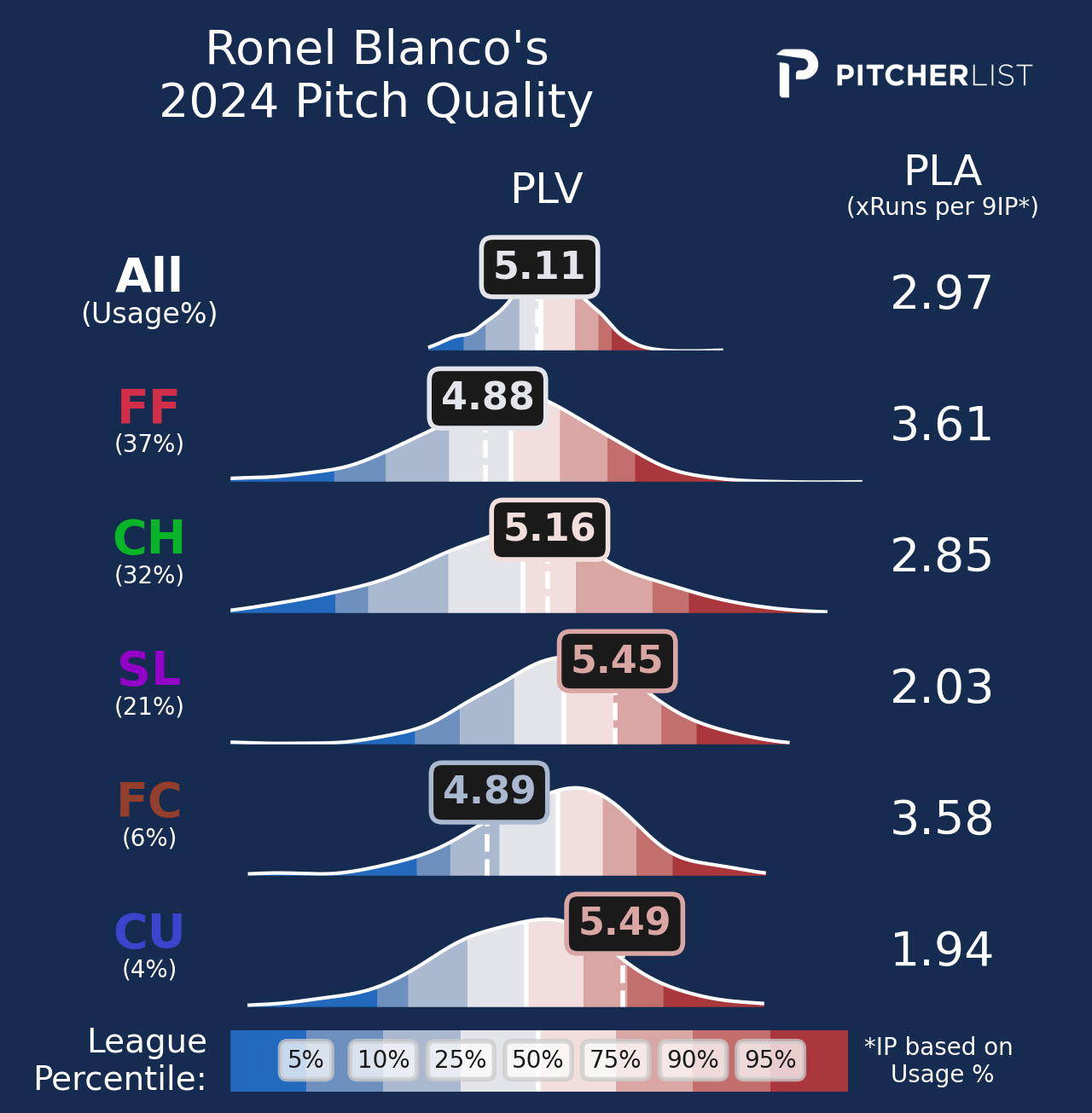
At a high level, that can be shown by his 21st percentile walk rate (10.5%) and extremely fortuitous luck (.181 BABIP and 89.5% LOB%). The HOTEL stats should regress (in a bad way), and his 0.91 WHIP will shoot up to match his elevated BB%. This isn’t to say that Blanco will be bad, but it is a word of caution for expecting his current results (or something close to them) to stick.
Four-Seam go brrrrr.

Analysis is pretty easy when the data, results, and eye test all line up. Ragans’ Four-Seam is legit, and so is he.
